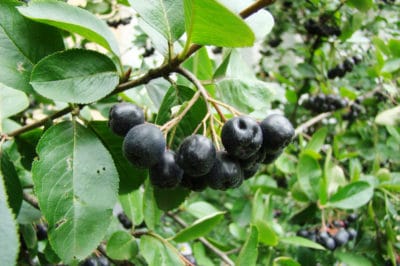Where Aronia Berry Grows
The aronia berry’s native range extends over much of eastern North America, from Newfoundland west to Minnesota and south to Georgia, Tennessee and Missouri. It grows in USDA plant hardiness zones 3 through 8, where winter lows range from to 10°F (-12.2°C) down to -40°F (-40°C).
Like blackberries, aronia bushes thrive almost anywhere in the wild. They handle everything from boggy, sandy or dry upland locations to damp, partially shady thickets. For the best home berry production, however, they like:
- The right spacing. Allow 3 to 4 feet between around the ‘Nero’ or ‘Autumn Magic’ cultivars and 5 to 6 feet between ‘Viking’ aronia and other shrubs. Proper spacing ensures good air circulation and discourages airborne fungal disease.
- Six to eight hours of daily sun. The harvests decrease with fewer than six hours.
- Well draining, sandy or sandy loam soil.
Expert gardener’s tip: For the quickest harvest, go with a second-year, nursery-started shrub between 2 and 3 feet tall. It should begin producing fruit in two to three years.
Fertilizing
Like blackberry plants, aronia bushes don’t need much fertilizing. To keep you soil replenished and your berry crop safe to eat, work 1-inch layers of aged manure, organic compost and humus into the soil each year in the fall. Top them off with a 2-inch layer of pine straw, wood chips or other organic mulch.
Watering
During the first two growing seasons after planting, give an aronia bush about 1 inch of water per week. This amounts to 6 gallons (22.7 liters) per 10 square feet of soil. Provide what rainfall doesn’t with one or two weekly watering sessions.
From the third growing season on, a healthy aronia berry needs supplemental water only during prolonged dry spells.
Pruning
Prune your aronia bush before it breaks dormancy in early spring. To maintain its density and stimulate new growth, prune dead or damaged branches back to the soil. Also remove new shoots spreading beyond its allotted space.
Disease Management
Pests virtually ignore aronia and diseases are almost as rare. To prevent harmless rust or leaf-spot infections, keep the foliage dry when watering.
